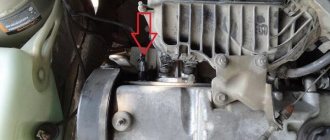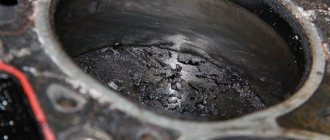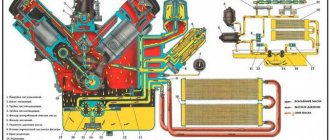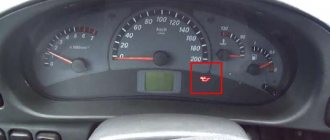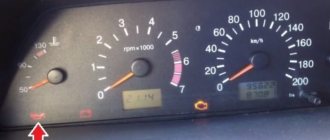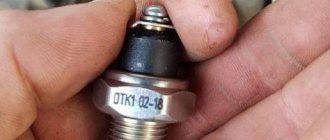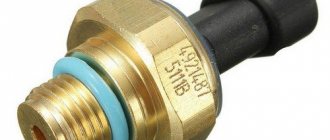A fairly common problem during the operation of an internal combustion engine is the oil pressure light on the dashboard coming on. This lamp indicates that the engine oil pressure in the engine lubrication system drops below the permissible level. Low engine oil pressure can occur for various reasons. Among the main malfunctions, experts identify:
- malfunction of the oil pressure sensor;
- low quality motor oil;
- mismatch of engine oil for a specific engine type;
- decrease in oil level as a result of a leak or increased oil consumption (waste, problems with rings or valve stem seals);
- using oil whose characteristics are not suitable for current operating conditions (viscosity index too high or low);
- oil pump malfunctions, decreased performance;
- blockage of the oil filter or oil channels of the engine lubrication system;
We also recommend reading the article about whether it is worth using additives to reduce engine oil consumption. From this article you will learn about the operating features of these compounds and the possible consequences of using additives in engine oil.
Next, we will focus on the problem when the emergency oil pressure reduction light comes on cold and/or hot. In other words, the oil pressure warning light does not go out or blinks/blinks after starting a cold engine, and the oil pressure warning light also lights up on a warm engine that is idling.
The main reasons for the oil pressure warning light to come on
So, the warning light usually lights up after starting the engine or when it is idling. There may be several reasons for this phenomenon, but the main thing is to understand and accept for yourself that this should be a signal that there is some kind of malfunction. Therefore, you need to take appropriate measures so as not to worsen the situation. In any case, if the lamp blinks, it means that you need to identify the malfunction and do everything to eliminate it as soon as possible.
Among the main reasons for the indicator to light up are the following:
- Reduced lubricant pressure in the system. This is one of the most common reasons, but even today there are owners who stubbornly do not notice signs of oil leakage or do not look into the engine compartment. Why does pressure drop, you ask? Because the oil gradually leaves the system. Therefore, you should pay attention to any stains on the engine or under the car where it is parked. Do not forget that by simply adding lubricant to the system, you do not solve the problem, but only forget about it for a while.
- Another reason for the warning light to blink is due to the use of low-quality oil filters. Some of the lubricant remains in them even when you stop the engine. If the filter is of dubious quality, then it does not retain oil, but it directly flows into the crankcase. Thus, a periodic drop in pressure occurs.
- Lack of lubrication may be associated with failure of the pressure relief valve. It should be in the closed position if the pressure level in the system is insufficient. However, when the valve fails or gets stuck, the pressure generated is not enough, which causes the warning light to light up.
- Another reason is a faulty pressure sensor. It is directly related to the operation of the control indicator, since it is connected to it by the same wire. As soon as the pressure returns to normal, the contacts should open, as a result of which the indicator should go out. This will not happen if the sensor itself has become faulty.
- The indicator also starts blinking if the oil pump screen is clogged. It acts as an obstacle to particles of dirt, metal, dust and any other unwanted elements that lead to wear on the pump. If the oil is not dirty, but of normal quality, then it freely penetrates through the mesh. When it is contaminated, the required pressure is not created in the system, which leads to the warning lamp coming on. Most often, this reason manifests itself on a cold engine, because as it warms up, the lubricant becomes more liquid and passes through the mesh much more easily.
- The oil pump itself may also fail. It is this that creates an acceptable level of pressure in the entire system. If this does not happen, the sensor contacts close, which leads to the appearance of a signal indicator on the panel. Therefore, in this case, you will have to dismantle the oil pan and pump to eliminate the problem.
Dependence of oil viscosity on engine wear
As the engine wears out and the gaps increase, it is recommended to switch to cheaper types of oils. For example, switching from synthetics to semi-synthetics. The operating viscosity will decrease, which will increase the oil film in the mating parts.
It happens that after changing the oil the oil pressure light comes on. Sometimes this is due to a change in oil type, when the old one is not completely drained and it comes into conflict with the new type. Then the lubricant from a liquid state can turn into a consistency and clog the oil lines.
However, more often it happens that the new oil filter is to blame. To find out the cause of the malfunction, you need to change the filter and see if the pressure lamp goes out. If not, then you need to open the engine filler neck and, with the engine running, find out whether the oil rises to the valve cover. If not, then the problem is in the oil pump.
How does the oil sensor work and why can it fail?
Now let's consider the situation if you are on the road and the low pressure indicator has triggered. The very first thing you need to do is stop the vehicle and turn off the engine. As soon as it cools down, you will have to check the lubricant level in the system. There is a special dipstick under the hood for this purpose. It is wiped dry and immersed in its original place. It is quite possible that the level will be below the minimum level. This means that somewhere there is a leak or depressurization of connections. You can set off again only after adding oil to the engine. If the lamp continues to light after starting and does not go out subsequently, it makes sense to think about towing the car to the nearest service station or to a trusted auto mechanic. The matter may turn out to be quite serious, so it is advisable to conduct the examination in a calm environment.
Since we have already said that the causes of low pressure may be associated with a faulty sensor, it would be useful to understand the principle of operation of this device. There are certain contacts inside it. Until the ignition is turned on, there is no pressure in the system, so the contacts are closed. When you turn the key and turn on the ignition, but before the starter starts, the warning lamp should be on. If this does not happen, then there may be some kind of malfunction. Maybe the light bulb itself simply burned out, or maybe the contacts were broken or the sensor itself failed. As soon as we start the engine, the contacts open, leading to the light bulb going out.
When the pressure lamp lights up does not indicate a malfunction
After turning the key in the ignition switch, the oil pressure lamp lights up.
This indicates that there is currently no operating pressure in the system. After starting the engine, the light may not go out for several seconds. This happens for several reasons:
- Thick oil after a long stay. It slowly fills the lubrication system. To avoid this effect, it is preferable to use synthetic and semi-synthetic oils.
- First of all, the main and connecting rod journals are filled with lubricant. Only then does the oil reach the sensor and it begins to show pressure.
- Strong car roll when driving. In this case, the light begins to flicker because centrifugal force pulls the oil away from the oil receiver, and it cannot suck in enough lubricant. Therefore, for cars that constantly drive in sport mode, a dry sump is used.
How to check pressure
If it is not possible to contact a car service in the near future, you can try to find the cause yourself, and for this we need to find out how to check the oil pressure. A special device that measures the pressure in the system is designed for these purposes. It is sold ready-made or you can make it yourself based on any pressure gauge, a rubber hose with a fitting, the thread of which should be the same as that of the oil sensor.
First you need to unscrew the thread on the sensor, preparing for the fact that oil will immediately begin to flow. After this, a pressure gauge is inserted into the system and the engine is started. At the time of startup, a second person must watch the instrument readings. If the value is less than 0.5 kg/cm2, it is necessary to stop the engine.
What oil pressure should be at idle?
The optimal oil pressure at idle speed differs for different brands of engines. The design of the power unit affects this.
At idle, the pressure of domestic passenger cars does not drop below 0.2 bar, while for diesel engines the figure is approximately 0.3 bar. For ZMZ engines the pressure is about 0.4 bar, for foreign cars with a power unit volume of 1.4 liters, the pressure is approximately 0.6 bar.
Exact data is indicated in the user manual.
Advice for car enthusiasts without car repair experience
What to do if trouble happens on the road? The most logical course of action is to check the main causes of low oil pressure as they become more expensive.
Lack of oil in the engine sump
Where can it go? Worn out engines consume oil during operation, loose gaskets cause oil to leak onto the ground, a faulty turbine or damaged housing will lead to the release of oil under pressure. Having opened the hood, inspect the engine compartment and the ground under the car - the oil leaves greasy traces, and it is impossible not to notice them.
Each internal combustion engine has a special dipstick that is used to check the oil level.
The dipstick ring is painted in a bright color
Finding out the oil level is quite easy. You need to completely pull out the dipstick, wipe it with a rag or napkin, and insert it back until it stops. Then pull it out again to determine the oil level. It should be between the top and bottom lines on the dipstick.
The oil level should be within the marks on the dipstick
If the oil level is low, be sure to top it up. Top up in small portions, monitoring the level.
The place where you need to fill the oil is indicated by the already familiar “oil can” symbol.
Sensor or wiring fault
Over time, the connectors oxidize, and during repairs, the wires get caught and come off. You need to remove the connectors and inspect them for oxidation. The oxide on the connectors is usually green or dark brown. This deposit should be thoroughly cleaned with a file or sandpaper.
A coating of dirt and oxides prevents the passage of electric current
Very often, troubles are hidden in the sensors, but without checking the oil pressure with a pressure gauge, this will not be clear. You can visually assess the condition of the sensor - whether there is any damage, whether the connectors are loose, whether the wire is attached to it at all.
The oil pressure sensor is usually located next to the oil filter or on the cylinder head. Depending on the car model, the sensor can be located in completely different places. To determine exactly where it is located, you need to study the car’s operation and repair manual, or ask a car mechanic.
The only way to check the functionality of the sensor is to replace it with a known good one.
Wrong oil
If too thin oil is poured into a worn engine, the pump will not be able to create the required pressure. Therefore, it is better to use oils prescribed by the manufacturer. Contact specialized oil change services. Employees of these institutions have catalogs of oils recommended for various brands of cars.
In worn-out engines, condensation collects in the oil or coolant gets into the oil. This leads to the appearance of an air-oil emulsion, which reduces the pressure in the oil lines (air is compressed, unlike oil). The emulsion is clearly visible if you open the oil filler neck.
Yellow-brown foam on the oil filler neck is a sign of foreign liquids getting into the oil
If there is a lot of emulsion, you need to change the oil and eliminate the cause of liquid getting into the oil. If it is condensation, you should periodically “walk” the car over long distances. If it is coolant, replace the cylinder head gasket and test the engine parts for leaks.
Clogged or faulty oil filter
If you changed the oil a long time ago and added oil from different manufacturers, sediments and resins can tightly clog the surface of the filter element. If a problem occurs after changing the oil, most likely you were given a filter that does not fit this car model. Car filters are equipped with a special valve that retains some of the oil in the filter. An incorrect valve design will “lock” the oil in the filter and prevent it from moving through the channels. Changing the oil and filters should eliminate these causes.
Other reasons require special tools for diagnosis, and troubleshooting requires a garage and repair skills. Therefore, it is best to entrust repairs to specialists from a service station.
A clogged or faulty oil filter can cause scuffing and engine damage.
- It is important to know that the indicator lamp will not light up just like that, there is a malfunction here, so it is worth fixing them as soon as possible.
- There may be several reasons for the signal, and all are not covered in this article. Do not delay in identifying breakdowns, because they can lead to much more complex consequences.
- Remember that motor oil plays a very important role in the motor processes that occur inside a car engine. Monitoring the oil level is the primary task of every driver.
How far can you travel if the indicator is on?
The answer to this question depends on why the lamp came on. If the indicator is active, then the first thing to do is check the amount of oil. If it is less than the established limit, and topping up is not possible, then you can drive the car 3–5 km at medium speeds at low speed to the place where the oil level is restored to normal.
You should not drive a car with insufficient lubricant in the engine. Otherwise, the engine will wear out faster and there will be a risk of complete breakdown. If the light starts flashing or stays on, try to fix the problem as quickly as possible.
Sources
- https://avto-kul.ru/neispravnosti-v-puti/zagorelas-kontrolnaya-lampa-davteniya-masla.html
- https://maslo.biz/interesting/zagoraetsya-lampochka-davleniya.html
- https://mirsmazok.ru/motornye-masla/gorit-lampochka-davleniya-masla-osnovnye-prichiny/
- https://fastmb.ru/autoremont/540-zagorelas-lampochka-davleniya-masla.html
- https://osensorax.ru/remont/chto-delat-esli-zagorelas-lampa-davleniya-masla
- https://topmekhanik.ru/gorit-lampochka-masla/
- https://etlib.ru/blog/948-gorit-lampochka-masla
- https://mojcar.ru/ustrojstva-avtomobilya/dvigatel/u-vas-gorit-lampochka-davleniya-masla-no-maslo-v-norme.html
- https://rad-star.ru/pressroom/articles/zagorelas-lampochka-davleniya-masla/
[collapse]
Simple malfunctions - about “lubrication”
The very first and most common reason is – insufficient amount of oil in the engine . Beginners neglect the level and do it in vain. It’s quite simple to determine - we pull out the oil dipstick and see if it’s dry, then we should sound the alarm - we MUST add it to the required level, the engine is experiencing “ oil starvation ”. Fortunately, now the sensor is triggered at a critical but acceptable level.
Second - not timely replacement! Some of us drive on oil for more than 20, or even 30,000 kilometers; it simply turns into mush, after which it is very difficult to wash the inside of the engine! Accordingly, if there is no liquid lubricant, the lamp will signal you about this; such behavior is simply unacceptable. Often the engine cannot be saved, this is especially true on loaded units, for example, on TURBO. So we set ourselves a rule: we MUST change the oil as prescribed by the dealer, and I would even change it even more often, for example, now that my warranty has expired, I change it after 10,000 km, instead of 15,000 recommended by the official dealer.
In 50% of cases, the indicator lights up precisely because of these reasons, so remember them, they are really important, if you follow these rules, then perhaps your sensor will never light up.
The purpose of the light bulb and why it lights up
In our article, I will try to tell you in detail about all the possible reasons why such an unpleasant phenomenon occurs, such as the oil pressure light on a VAZ 2110, as well as ways to determine the cause and methods for eliminating detected faults. So:
- The oil pressure warning light on the dashboard is an indicator that warns or, in extreme cases, confirms that something is wrong with the engine
- The list of possible reasons when the oil pressure light comes on on a VAZ 2110 may include the following: a problem in the operation of the engine, poorly performed repairs to the power unit, or a possible lack of regular, timely and necessary maintenance of the machine
- Whatever the discovered reason, it does not play a special role and the fact that you find out who is to blame for this malfunction will not bring you relief, and the cost of repairs will not decrease from this
- It is very important here to understand that you have a problem and you need to solve it urgently
- The main thing for you now is to detect the malfunction itself, due to which the oil pressure lamp on the VAZ 2110 lights up
- And taking actions to eliminate it as soon as possible, if you do not attach importance to this, the consequences can become much more complex and more global
- I present to your attention the main and common reasons why the oil pressure lamp on the VAZ 2110 indicates a malfunction
The oil pressure light came on VAZ 2110 8 valves causes of malfunction
- To the beginning of the forum
- Forum Rules
- Old design
- FAQ
- Search
- Users
Replaced the sensor and everything returned to normal.
and in general it’s better to buy a new oil pickup, they say it’s cheap, I’ll probably change it myself, purely as a precaution
.have you even seen it clearly?
The oil I use is ESSO 10W-40. Changed it about 1.5 years ago
Is it worth changing the oil filter?
burn. Did you at least clearly see it? You were going to change it for prevention. piece of iron with holes hehe
I repeat once again that I changed the oil 2000 km ago this summer.
When changing the oil receiver, I understand that the oil must be drained. It's a shame I only recently changed the oil.
Information on icons and features
You can not
start topics You
cannot
reply to messages You
cannot
edit your messages You
cannot
delete your messages You
cannot
vote in polls You
can
attach files You
can
download files
Source
About additives and properties of oils for increasing pressure in the system
Some car enthusiasts are interested in whether there is motor oil that increases the pressure in the system. Rather, we are talking about special additives that improve its characteristics. The main result from the use of such compounds (for example, SUPROTEC) can be called the restoration of the previous parameters of operating processes in the engine. The surfaces of working parts and mechanisms of the piston group, worn out by constant friction, are partially restored, and their oil-holding capacity increases. As a result, fuel combustion efficiency increases and engine compression improves. Many oils contain special additives that are aimed at reducing engine lubricant consumption.
This is where we will end today’s material. There are many interesting articles ahead of us in the field of engine maintenance and car maintenance in general. Therefore, subscribe to our updates to receive useful newsletters in the future. Bye!
On the dashboard of the car there are light indicators that signal problems in the operation of one or another mechanism of the car. One of them is the oil pressure lamp.
Many drivers have encountered a situation where the oil pressure indicator (OP) lights up and does not go out. This often happens at idle, after starting the car. Next, we will look at what reasons could cause the indicator llama to turn on and how to troubleshoot possible problems?
Engine wear and pressure boosting additives
In recent years, a new type of automotive chemicals has appeared on the shelves - additives for increasing oil pressure and engine compression. If parts wear out, is there any point in using them?
The work of additives is aimed at restoring the original dimensions of worn parts, as well as improving the oil-holding capacity of rubbing surfaces.
There was a significant reduction in oil consumption using such products as Rimet and Suprotek. The service life of the engine before major overhaul was also increased.
